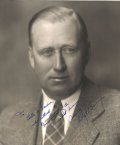Leroy Grumman
| Leroy Grumman | |
|---|---|

Leroy Grumman, 1895–1982 (photo: 1942)
|
|
| Born |
Leroy Randle Grumman 4 January 1895 Huntington, New York |
| Died | 4 October 1982 (aged 87) Manhasset, New York |
| Occupation | Co-Founder, Grumman |
| Spouse(s) | Rose Marion Werther (1898–1995) 1921–1982 (his death) |
| Children | Three daughters: Marion Grumman Phillips, Florence Grumman Hold, and Grace Grumman Nelson One son: David Grumman |
Leroy Randle "Roy" Grumman (4 January 1895 – 4 October 1982) was an American aeronautical engineer, test pilot, and industrialist. In 1929, he co-founded Grumman Aeronautical Engineering Co., later renamed Grumman Aerospace Corporation, and now part of Northrop Grumman.
Born in Huntington, New York, Grumman's forebears had Connecticut roots and owned a brewery. When he was a child, his father, George Tyson Grumman, owned and operated a carriage shop and later worked for the post office. From an early age, "Red Mike" (a nickname he gained because of his red-blond hair) demonstrated an interest in aviation, and in his 20 June 1911 high school salutatory address at Huntington High School, Grumman predicted that "[t]he final perfection of the aeroplane will be one of the greatest triumphs that man has ever gained over nature."
Grumman went on to earn a Bachelor of Science degree in mechanical engineering from Cornell University in 1916. He landed his first job in the engineering department of the New York Telephone Company. After the United States entered World War I, he enlisted in the U.S. Naval Reserve in June 1917 as a machinist's mate, 2nd class, and was sent to Columbia University for a course on "subchaser" engines.
Although Grumman applied for flight training, he failed a medical evaluation when the examining board incorrectly diagnosed flat feet. A clerical error, however, had him report to a course in aircraft inspection for pilot trainees at Massachusetts Institute of Technology. Without revealing the error in classification, he entered primary flight training at Naval Air Station Miami and successfully completed advanced flight training in Pensacola, Florida in September 1918. Raymond P. Applegate, his flight instructor, recalled several years later that his young charge "was very, very reticent. Most of the guys, after they [learned to] fly, they became tougher than hell. Grumman didn't." He was commissioned an ensign (as naval aviator No. 1216), eventually becoming a flight instructor, and assigned to a bombing squadron.
...
Wikipedia
